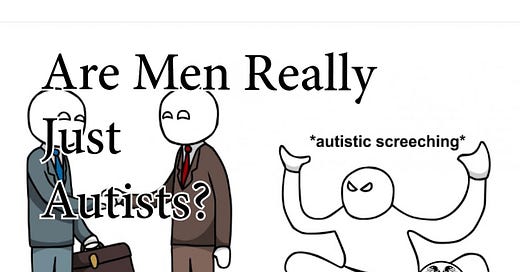If you prefer audio of this article, click here.
This will be a bit of a different style of article than you normally see here. It will be more of an open question, a dialogue, a ramble. Hey, I’m allowed one of these occasionally.
The “extreme male brain” theory of autism is a trope on the right. It’s an attractive idea, not least because it confirms that there are, in fact, inherently male and female natures based on material facts of biology. It makes men into the hard-nosed, uncompromising truth seekers whose mantra is “facts don’t care about your feelings”, and women into the wishy-washy but diplomatic mother hens whose job it is to arbitrate between the socially retarded man-children coming to blows over which way the Hot Wheels car is pointing. Everybody gets a place in the sun.
It also has some indirect evidence going for it. In the 90s, Borat’s academic brother conducted a large series of questionnaires that found that a) men excel at systematizing and women don’t, and b) autistic people also excel at systematizing. The mechanism that Baron-Cohen has proposed is elevated levels of exposure to testosterone in utero leading to autism. The usual suspects have come out against the hypothesis on the basis that it confirms gender stereotypes and other progressive nonsense, but the theory has received some empirical confirmation, with one study concluding that “Individuals with [autism] had slightly more male-type brains”.1
So there’s something to the extreme male brain (EMB) hypothesis. But there are some serious problems with it, and in this article we’ll offer some challenges to it. I preface these challenges by saying I am no expert in neurology or psychology, but I do have a good idea of what characterizes archetypal masculinity, probably a better idea than most. And I freely admit I could be wrong too—I could well have misinterpreted something important about the thesis. With that, let’s dig into it.
First, staying with neurobiology for a moment. There’s no question but that the brain is a sexed organ. It displays anatomical differences between men and women and these obviously affect functioning, both in qualitative and quantitative ways. The EMB hypothesis tells us that men are better at pattern recognition and rule following, whereas women are more sensitive to emotion and have greater social intelligence. We would expect these differences to manifest in corresponding brain structures, but we seem to find the opposite.2
Women have a larger hippocampus, the brain structure governing learning and memorization. One would think that men—the sex supposedly more given to rules, procedures, and information—would be biologically equipped with better memory, but apparently we have just the opposite. Women are born rule-followers; despite being gaslit by feminism for a century, they like clear rules and authority. They’re detail-oriented, have much better memory than men, and are more likely to get upset and flustered without clear parameters. This is why they make good household managers but poor executives.
Men, on the other hand, tend to be better able to navigate ambiguity, which is why they’re the natural CEO, general, and paterfamilias. Biology supports this, because men have a larger amygdala, the brain structure governing emotion, fear, and instinct. You want the truly masculine man around in a crisis, not just because he can bench 225, but because he doesn’t piss himself when his procedural framework dissolves in the face of complexity—he trusts his gut, and doesn’t really need to justify it. This doesn’t really square with “realz over feelz”, does it? Not, at least, if by “realz” we mean abstract reason. While men do tend to excel at abstract reason beyond women, this may simply be an artifact of the male variability hypothesis, which we’ve discussed elsewhere. It’s true that men have better pattern recognition, hence higher rates of racism3 (except when it comes to mate selection),4 but pattern recognition is something rather different than abstract reason. Pattern recognition is the ability to integrate a large empirical dataset, whereas abstraction is the ignoring of empiricism altogether. Autists excel at pattern recognition,5 but often struggle to acquire abstract conceptual thinking.6 So our picture is much more complicated than the EMB hypothesis might suggest: the archetypal male sees patterns like an autist, but is also instinctual and gut-oriented, something autists definitely are not. But this isn’t even the main objection.




